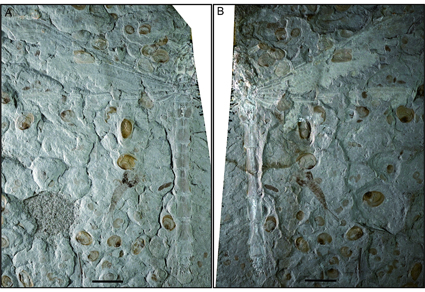Abstract
The mesuropetalid dragonfly Sinomesuropetala daohugensis Boudet, Nel & Huang, 2023, is here revised based on a new well-preserved dragonfly from the Haifanggou Formation of Inner Mongolia, northeastern China. The new specimen allows us to complete the forewing characters of this species, showing the close relationship of Sinomesuropetala Boudet, Nel & Huang, 2023 with Mesuropetala Handlirsch, 1906. The mesuropetalid dragonflies are currently recorded from the Late Jurassic and Lower Cretaceous deposits of east Asia, East Central South Europe, and southern America, indicating the wide distribution and the possible long-distance migration ability of some basal aeshnopteran dragonflies during these epochs.
References
- Bechly, G. (1996) Morphologische Untersuchungen am Flügelgeäder der rezenten Libellen und deren Stammgruppenvertreter (Insecta; Pterygota; Odonata), unter besonderer Berücksichtigung der Phylogenetischen Systematik und des Journal Pre-proof Grundplanes der Odonata. Petalura, 2, 1–402.
- Bechly, G. (2010) Additions to the fossil dragonfly fauna from the Lower Cretaceous Crato Formation of Brazil (Insecta: Odonata). Palaeodiversity, 3 (Supplement), 11–77.
- Bechly, G. (2016) Phylogenetic systematics of Odonata. Available from: https://bechly.lima-city.de/phylosys.htm (accessed 18 August 2023)
- Bechly, G., Nel, A., Martínez-Delclòs, X., Jarzembowski, E.A., Coram, R., Martill, D., Fleck, G., Escuillié, F., Wisshak, M.M. & Maisch, M. (2001) A revision and phylogenetic study of Mesozoic Aeshnoptera, with description of several new families, genera and species (Insecta: Odonata: Anisoptera). Neue Paläontologische Abhandlungen, 4, 1–219.
- Boudet, L., Nel, A. & Huang, D. (2023) A new basal hawker dragonfly from the earliest Late Jurassic of Daohugou, northeastern China (Odonata: Anisoptera: Mesuropetalidae). Historical Biology, 35 (8), 1267–1273. https://doi/full/10.1080/08912963.2022.2086804
- Brodie, P.B. (1845) A history of the fossil insects in the Secondary rocks of England, accompanied by a particular account of the strata in which they occur, and of the circumstances connected with their preservation. John Van Voorst (publ.), London, xviii + 130 pp. https://doi.org/10.5962/bhl.title.52321
- Fabricius, J.C. (1793) Entomologia systematica emendata et aucta, secundum classes, ordines, genera, species, adjectis synonymis, locis, observationibus, descriptionibus. Vol. 3. C G Proft, Hafniae [Copenhagen], 488 pp. https://doi.org/10.5962/bhl.title.125869
- Germar, E.F. (1839) Die versteinerten Insecten Solenhofens. Nova Acta PhysicoMedica Academiae Caesareae Leopoldino-Carolinae Naturae Curiosorum, 19 (1), 187–222.
- Giebel, C.G. (1856) Die Insekten und Spinnen. In: Geibel, C.G. (Ed.), Fauna der Vorwelt mit steter Berücksichtigung der lebenden Thiere. 2 (1). Brodhaus, F.A. (publ.), Leipzig, pp. i–xviii + 1–511.
- Handlirsch, A. (1906) Die Fossilen Insekten und die Phylogenie der Rezenten Formen, parts I–IV. Ein Handbuch fur Palaontologen und Zoologen, 1906, 1–640.
- Handlirsch, A. (1939) Neue Untersuchungen über die fossilen Insekten mit Ergänzungen und Nachträgen sowie Ausblicken auf phylogenetische, paläogeographische und allgemeine biologische Probleme. Teil 2. Annalen des Naturhistorischen Museums in Wien, 49, 1–240.
- Huang, D., Nel, A. & Lin, Q. (2003) A new genus and species of aeshnopteran dragonfly from the Early Cretaceous of China. Cretaceous Research, 24, 141–147. https://doi.org/10.1016/S0195-6671(03)00027-2
- Li, Y., Chang, S., Zhang, H., Wang, J., Pei, R., Zheng, D., Fang, Y. & Hemming, S.R. (2023) A chronostratigraphic and biostratigraphic framework for the Yanliao Biota of northeastern China: Implications for Jurassic terrestrial ecosystems and evolution. Palaeogeography, Palaeoclimatology, Palaeoecology, 630, 111818. https://doi.org/10.1016/j.palaeo.2023.111818
- Nel, A., Martínez-Delclòs, X., Paicheler, J.-C. & Henrotay, M. (1993) Les ‘Anisozygoptera’ fossiles. Phylogénie et classification (Odonata). Martinia, Numéro Hors Série, 3, 1–311.
- Pritykina, L.N. (1968) Strekozy Karatau (Odonata). [Dragonflies from Karatau (Odonata)]. In: Rohdendorf, B.B. (Ed.), Yurskie Nasekomye Karatau. [Jurassic insects from Karatau]. Nauka Press, Moscow, pp. 26–54.
- Riek, E.F. & Kukalová-Peck, J. (1984) A new interpretation of dragonfly wing venation based upon Early Carboniferous fossils from Argentina (Insecta: Odonatoidea) and basic characters states in pterygote wings. Canadian Journal of Zoology, Ottawa, 62, 1150–1166. https://doi.org/10.1139/z84-166
- Selys Longchamps, E. de (1854) Monographie des Calopterygines. Mémoires de la Société royale des Sciences de Liége, 9, i–xi + 1–291. https://doi.org/10.5962/bhl.title.60461


